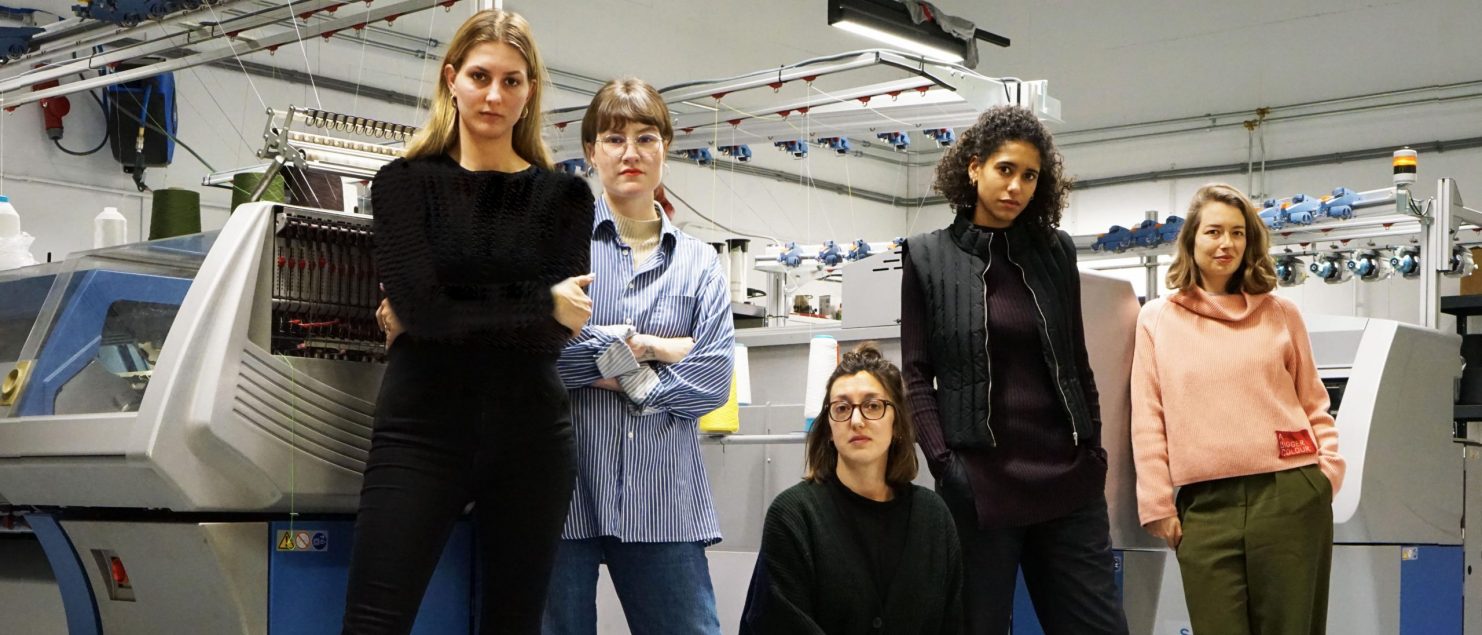WOMEN BEHIND THE MACHINES
The all-female programming team of KNITWEAR LAB
WOMEN BEHIND THE MACHINES
Women do the needle work and men handle the machines: this sounds like a scenario from the last century. The reality is that in many knitwear factories this traditional gender division is still in place. At KNITWEAR LAB we turned this around. Meet our incredible women behind the machines!
At KNITWEAR LAB all our in-house programmers happen to be female. This is in contrast with the knitwear industry where women are largely underrepresented in programming jobs. ‘I guess this is because you have to deal directly with the machines, which includes steel, oil and… broken nails’ jokes our senior programmer Francesca Pedrini.
Needless to say, we do not believe any of the sexes is more competent for the job of programmer. ‘I have never thought that this or any other profession for that matter is a “male” or a “female” job. I absolutely detest the division based on gender’ is how our junior programmer Eerika Yli-Rahko strongly phrases our vision. Nevertheless, we are very proud of what our incredible team of women has accomplished and the way they represent women in a male dominated profession.
Being a programmer at KNITWEAR LAB is an all-encompassing job which requires not only a mathematical mastermind and hardcore machine handling skills, but also creativity and a design-driven mentality. We place just as much emphasis on technological innovation as on design. ‘Being both the designer and programmer of a product comes in handy when you are searching for innovative solutions’ enthuses Francesca. ‘I would say the technology and the design are complementary: they solve each other’s issues …. at least most of the time!’
Many of our programmers come from a design background. Eerika discovered her passion for knitwear while she studied fashion design at Aalto University. During her internship at KNITWEAR LAB she grew into the role of programmer. With every project she gets challenged to develop her technical skills further and discover new creative solutions. Annika Klaas is the latest addition to our team. She specialized in knitwear during her fashion design studies at the Reutlingen University. ‘I realized that in order to become a better knitwear designer, I had to become a better programmer’ enthuses Annika. In addition to her job as our senior programmer, she will start a PHD at KNITWEAR LAB with the Reutlingen University, for which she will develop software that translates 3D scans directly to programming software.
In our female dominated bubble none of our programmers experienced prejudice. Our co-founder Cherish Brouwer had a different experience. Cherish established KNITWEAR LAB together with Thijs Verhaar, when she was just in her mid-twenties. She has been responsible for KNITWEAR LAB’s creative direction from the start and co-managed the company alongside her middle-aged male counterpart. However, in business meetings with clients she often gets addressed as Thijs’ secretary or daughter instead of an equally knowledgeable and skillful business partner. The prejudice has also been remarkable at factories abroad. ‘I often got surprised responses when I started to operate the machines. They did not expect that – besides being a designer – I would also be able to handle the machines and work as a programmer. I guess they are not used to the duality of skills – or perhaps they hardly ever see a woman in these kind of positions’ says Cherish.
So, what is the reason that women in programming and machine handling jobs is still such a rare phenomenon? ‘I think the main problem is that nobody throughout my education path has ever pointed out to me that this is a professional career I could consider’ explains Francesca. Our project manager Gaia Liesdek confirms this: ‘Knitwear programming is a very specific skill and during my studies there was not a lot of focus on this.’ Fortunately, we see some small changes happening. A few academies and universities now start to buy industrial knitwear machines for their students. At KNITWEAR LAB we contribute to this by organizing an Industrial Knitwear course. Many of the participants are female!
We envision a bright future for the knitting industry. Gaia Liesdek: ‘More industries discover the potential of knitwear. This means that more doors are opening for people that want to learn about the technical aspects of knitting, including women. As KNITWEAR LAB we play a big part in this. It is our aim to inspire different industries with sustainable, technically advanced and design driven knitwear solutions. I love being part of an inclusive, boundary pushing company, where we get the opportunity to constantly develop our skills, through creating innovative products for our clients.’
